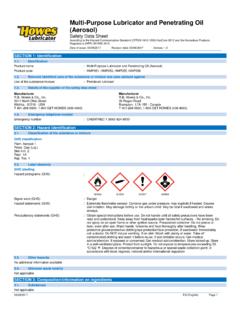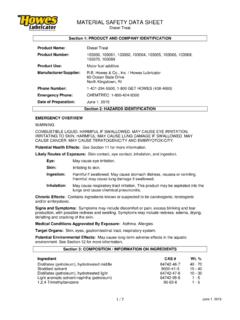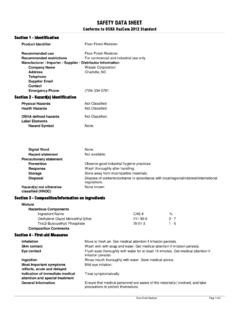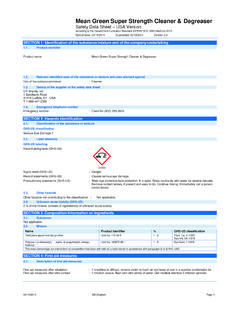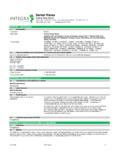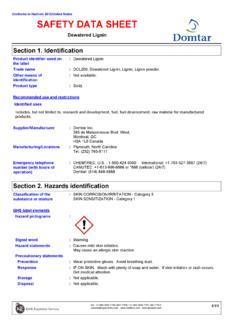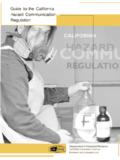Transcription of Diesel Treat - Howes Lubricator
1 Diesel Treat Safety Data Sheet According to the Hazard Communication Standard (CFR29 ) hazcom 2012 and the Hazardous Products Regulations (HPR) WHMIS 2015 Date of issue: 03/08/2017 Revision date: 03/08/2017 Version: 03/08/2017 EN (English) Page 1 SECTION 1: Identification Identification Product name : Diesel Treat Product code : 103060, 103061, 103062, 103064, 103065, 103066, 103068, 103070, 103089 Relevant identified uses of the substance or mixture and uses advised against Use of the substance/mixture : Motor fuel additive Details of the supplier of the safety data sheet Manufacturer Howes & Co., Inc. 3511 North Ohio Street Wichita, 67219 - USA T 401-294-5500, 1-800 GET Howes (438-4693) Manufacturer Howes & Co.
2 , Inc. 35 Regan Road Brampton, L7A 1B2 - Canada T 401-294-5500, 1-800 GET Howes (438-4693) Emergency telephone number Emergency number : CHEMTREC 1 (800) 424-9300 SECTION 2: Hazard identification Classification of the substance or mixture GHS classification Flam. Liq. 4 Carc. 2 Repr. 2 Asp. Tox. 1 Label elements GHS labelling Hazard pictograms (GHS) : GHS08 Signal word (GHS) : Danger Hazard statements (GHS) : Combustible liquid. Suspected of causing cancer. Suspected of damaging fertility or the unborn child. May be fatal if swallowed and enters airways Precautionary statements (GHS) : Obtain special instructions before use.
3 Do not handle until all safety precautions have been read and understood. Keep away from heat/sparks/open flames/hot surfaces. - No smoking. Wear protective gloves/protective clothing/eye protection/face protection. If swallowed: Immediately call a doctor. Do NOT induce vomiting. If exposed or concerned: Get medical advice/attention. Store in a well-ventilated place. Keep cool. Store locked up. Dispose of contents/container to hazardous or special waste collection point, in accordance with local, regional, national and/or international regulation Other hazards No additional information available Unknown acute toxicity Not applicable SECTION 3: Composition/information on ingredients Substances Not applicable Diesel Treat Safety Data Sheet According to the Hazard Communication Standard (CFR29 ) hazcom 2012 and the Hazardous Products Regulations (HPR) WHMIS 2015 03/08/2017 EN (English) 2/9 Mixtures Name Product identifier % Distillates, petroleum, hydrotreated middle (CAS-No.)
4 64742-46-7 Stoddard solvent (CAS No) 8052-41-3 Petroleum distillates, hydrotreated light (CAS No) 64742-47-8 Benzene, 1,2,4-trimethyl- (CAS No) 95-63-6 Solvent naphtha, petroleum, light aromatic (CAS-No.) 64742-95-6 Nonane (CAS No) 111-84-2 Xylenes (o-, m-, p- isomers) (CAS No) 1330-20-7 Naphthalene (CAS No) 91-20-3 Ethylbenzene (CAS No) 100-41-4 SECTION 4: First aid measures Description of first aid measures First-aid measures after inhalation : If breathing is difficult, remove victim to fresh air and keep at rest in a position comfortable for breathing. Get medical advice/attention if you feel unwell.
5 First-aid measures after skin contact : If skin irritation occurs: Wash skin with plenty of water. Obtain medical attention if irritation persists. First-aid measures after eye contact : IF IN EYES: Rinse cautiously with water for several minutes. Remove contact lenses, if present and easy to do. Continue rinsing. If eye irritation persists: Get medical advice/attention. First-aid measures after ingestion : IF SWALLOWED: immediately call a POISON CENTER or doctor/physician. Do NOT induce vomiting. Never give anything by mouth to an unconscious person. Most important symptoms and effects, both acute and delayed Symptoms/effects after inhalation : May cause irritation to the respiratory tract.
6 Symptoms/effects after skin contact : May cause skin irritation. Symptoms may include redness, drying, defatting and cracking of the skin. Symptoms/effects after eye contact : May cause eye irritation. Symptoms may include discomfort or pain, excess blinking and tear production, with possible redness and swelling. Symptoms/effects after ingestion : May be fatal if swallowed and enters airways. This product may be aspirated into the lungs and cause chemical pneumonitis. May cause stomach distress, nausea or vomiting. Indication of any immediate medical attention and special treatment needed Symptoms may be delayed. In case of accident or if you feel unwell, seek medical advice immediately (show the label where possible).
7 SECTION 5: Fire-fighting measures Extinguishing media Suitable extinguishing media : Foam. Carbon dioxide. Water fog. Unsuitable extinguishing media : Do not use water jet. Special hazards arising from the substance or mixture Fire hazard : Combustible liquid. Products of combustion may include, and are not limited to: oxides of carbon. Reactivity : No dangerous reaction known under conditions of normal use. Advice for firefighters Protection during firefighting : Keep upwind of fire. Wear full fire fighting turn-out gear (full Bunker gear) and respiratory protection (SCBA). Cool down the containers exposed to heat with a water spray.
8 SECTION 6: Accidental release measures Personal precautions, protective equipment and emergency procedures General measures : Use personal protection recommended in Section 8. Isolate the hazard area and deny entry to unnecessary and unprotected personnel. Eliminate sources of ignition. Use special care to avoid static electric charges. For non-emergency personnel No additional information available For emergency responders No additional information available Diesel Treat Safety Data Sheet According to the Hazard Communication Standard (CFR29 ) hazcom 2012 and the Hazardous Products Regulations (HPR) WHMIS 2015 03/08/2017 EN (English) 3/9 Environmental precautions Prevent entry to sewers and public waters.
9 Methods and material for containment and cleaning up For containment : Absorb and/or contain spill with inert material (sand, vermiculite or other appropriate material), then place in suitable container. Do not flush into surface water or sewer system. Wear recommended personal protective equipment. Methods for cleaning up : Sweep or shovel spills into appropriate container for disposal. Spilled material may present a slipping hazard. Provide ventilation. Reference to other sections For further information refer to section 8: "Exposure controls/personal protection" SECTION 7: Handling and storage Precautions for safe handling Precautions for safe handling : Keep away from sources of ignition - No smoking.
10 Avoid contact with skin and eyes. Avoid breathing dust/fume/gas/mist/vapours/spray. Do not swallow. Handle and open container with care. When using do not eat, drink or smoke. Use only outdoors or in a well-ventilated area. Hygiene measures : Wash contaminated clothing before reuse. Always wash hands after handling the product. Conditions for safe storage, including any incompatibilities Technical measures : Proper grounding procedures to avoid static electricity should be followed. Storage conditions : Keep out of the reach of children. Keep container tightly closed. Store locked up. Store in a well-ventilated place. Keep cool.

